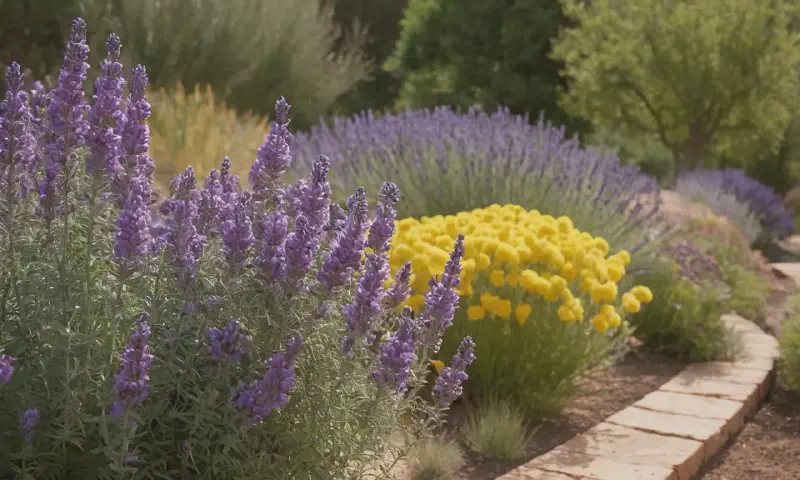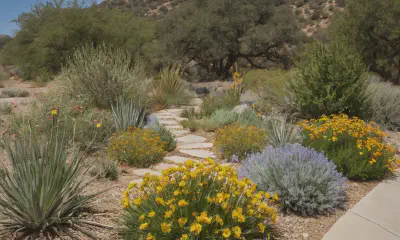
Summary
This blog post advocates for drought-tolerant flowers as a water-wise and cost-effective gardening choice. It dispels the myth that these plants lack aesthetic appeal, showcasing a diverse range of options categorized by bloom time and growth habit (spring, summer, climbers, groundcovers), including examples like coneflowers, lavender, and sedum. The post further details planting and care instructions, emphasizing deep, infrequent watering and minimal fertilization, while also addressing potential troubleshooting issues like wilting and lack of blooms. Ultimately, it promotes creating a beautiful, sustainable garden that thrives even in dry conditions.
Drought-Tolerant Flowers: A Water-Wise Choice
In a world increasingly concerned with water conservation and environmental sustainability, choosing drought-tolerant flowers for your garden is a smart and responsible decision. These resilient plants offer a beautiful alternative to water-hungry varieties, providing vibrant color and texture while significantly reducing your water consumption. The benefits extend beyond environmental responsibility; opting for drought-tolerant flowers also translates to considerable cost savings on your water bill and less time spent on intensive watering.
The misconception that drought-tolerant plants are dull and uninteresting is far from the truth. The range of options available is astonishingly diverse, encompassing a vast array of colors, shapes, sizes, and bloom times. From delicate, low-growing groundcovers perfect for edging pathways to tall, striking specimens that add vertical interest to borders, there’s a drought-tolerant flower to suit every garden style and preference. Whether you’re aiming for a burst of summer color, a calming palette of pastels, or a dramatic display of autumn hues, the possibilities are endless. This guide will explore the many benefits of choosing drought-tolerant flowers and provide you with the knowledge and tools to create a stunning, water-wise garden.
A Colorful Collection: Drought-Tolerant Flowers for Every Garden
Let’s delve into the diverse world of drought-tolerant flowers, categorized by their bloom time and growth habit. This selection offers a glimpse into the many options available to create a vibrant and water-wise garden.
Spring Bloomers:
Aubrieta (Aubrieta deltoidea): This low-growing groundcover bursts forth with a profusion of tiny, four-petaled flowers in shades of purple, pink, and white. It thrives in full sun to partial shade and well-drained soil, making it perfect for rock gardens or spilling over walls. Minimal care is required once established.
Arabis (Arabis caucasica): Another excellent groundcover, Arabis offers a carpet of white, pink, or lilac flowers in spring. It prefers full sun and well-drained soil, tolerating poor soil conditions remarkably well. Deadheading spent blooms encourages further flowering.
Summer Bloomers:
Coneflower (Echinacea): These daisy-like flowers are known for their striking central cones and long-lasting blooms. Available in various colors, from classic purple to vibrant orange and yellow, coneflowers are adaptable to a range of soil types and sun conditions. They are relatively pest-resistant and require minimal watering once established.
Lavender (Lavandula): Highly fragrant and visually appealing, lavender offers beautiful purple spires of flowers throughout the summer. It thrives in full sun and well-drained, slightly alkaline soil. Regular pruning after flowering helps maintain its shape and encourages bushier growth.
Sedum (Sedum spp.): This diverse genus encompasses a wide range of succulents, offering various textures, colors, and bloom times. Many Sedum varieties boast vibrant fall foliage, adding autumnal interest to the garden. They prefer full sun and well-drained soil, tolerating drought conditions exceptionally well.
Climbing Varieties:
- Clematis (Clematis spp.): While some Clematis varieties require more consistent watering, certain species are surprisingly drought-tolerant once established. Choose varieties specifically bred for drought tolerance. They offer a stunning display of large, showy flowers in various colors and climb readily with support. Regular pruning is essential to maintain their shape and encourage flowering.
Groundcovers:
- Thyme (Thymus spp.): Beyond its culinary uses, thyme offers a fragrant and attractive groundcover with tiny, delicate flowers in shades of pink, purple, and white. It thrives in full sun and well-drained soil, tolerating foot traffic and dry conditions.
This is just a small selection of the many drought-tolerant flowers available. When choosing plants for your garden, consider your local climate, soil type, and the amount of sunlight your garden receives. Remember to always check the specific requirements of the individual plant variety before purchasing. With careful planning and selection, you can create a beautiful and water-wise garden that thrives even in dry conditions.
Planting and Caring for Your Drought-Tolerant Garden
Creating a thriving drought-tolerant garden requires careful planning and execution, but the rewards are well worth the effort. Proper soil preparation is key to success. Before planting, amend your soil with organic matter like compost to improve drainage and water retention. Drought-tolerant plants don’t like soggy roots, so well-draining soil is crucial. Sandy loam is ideal, but you can improve heavy clay soils by adding organic matter and perlite to increase porosity.
Planting techniques are straightforward. Dig holes twice as wide as the root ball of your chosen plant, ensuring adequate space for root development. Gently loosen the roots before planting, ensuring they are not cramped. Backfill the hole with soil, firming it gently around the base of the plant. Water thoroughly after planting to help settle the soil and encourage root establishment.
Watering strategies are critical for drought-tolerant plants. The goal is to establish a deep, strong root system, not to keep the soil constantly moist. Water deeply and infrequently, allowing the soil to dry out somewhat between waterings. The frequency will depend on your climate, soil type, and the specific plant, but generally, less frequent, deeper watering is better than frequent shallow watering. A soaker hose or drip irrigation system is ideal for delivering water directly to the roots, minimizing water loss through evaporation.
Ongoing maintenance is relatively low-key. Deadheading, or removing spent blooms, encourages more flowering and prevents the plant from putting energy into seed production. Fertilizing is generally not necessary for drought-tolerant plants, as excessive fertilization can actually make them more susceptible to drought stress. However, a light application of a balanced, slow-release fertilizer in spring can be beneficial, especially in poor soils. Regularly inspect your plants for pests and diseases, addressing any issues promptly. Mulching around the base of the plants helps retain soil moisture, suppress weeds, and regulate soil temperature. With proper care, your drought-tolerant garden will reward you with beauty and resilience for years to come.
Troubleshooting Your Drought-Tolerant Garden
While drought-tolerant plants are resilient, they can still encounter problems. Wilting, often caused by insufficiently established roots or overly dry soil, can be addressed by deep watering. Lack of blooms might indicate insufficient sunlight or nutrient deficiency; ensure plants receive adequate sun and consider a light spring fertilization. Pest and disease issues are less common but can be managed with appropriate organic pesticides or fungicides if necessary. Early detection and prompt action are key to maintaining a healthy and vibrant drought-tolerant garden.





